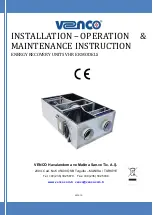
OPI_SMART LIFT 2.30 SL-2.35 SL-2.40 SL - HYMAX S 3000-S3500-S4000_V1.2_DE-EN-FR-ES-IT
107
6.1 Moving onto an obstacle
If the lifting rails or a lifting arm have been moved
onto an obstacle due to inattention of the oper-
ator, only the motor is blocked for the lifting rail or
lifting arm sitting on the obstacle. The lift switches
off as soon as the other lifting rail has moved out of
the control range of 64 mm. As an additional safety
measure, there is a temperature monitor integrated
into the motor winding which interrupts power if the
motor is overloaded. Any further operation of the
lift is only possible after some minutes have passed
(cooling of the motor: depending of the external
temperature). After a motor is blocked the v-belt
must be checked for any possible damage and
exchanged if required. Please contact your service
partner (dealer).
6.2 Emergency discharge
If there is a power outage or a defective motor the
lift can no longer be lowered. There is the option of
placing the lift into the lowest position.
An emergency discharge can only be
done by personnel who are trained to
operate the lift. Follow the conditions
to “Lower”.
Emergency discharge procedure
• Disconnect from power or switch off the main
switch and secure against switch on.
• Remove both v-belt covers.
•
Carefully turn the hexagonal nut at the upper
end of the lift spindle anti-clockwise using a suit-
able tool. This procedure is to be done alternate-
ly (5 cm) on both lift spindles, until the vehicle is
placed on the wheels and the lifting arm can be
positioned in the starting position. If there is a de-
fect stop the lift and secure against unauthorised
use. Inform customer services.
6.3 Triggering the safety mechanism
The lift is provided with a safety mechanism that ac-
tivates when the lift nut breaks. After a break of the
lift nut, the safety nut moving with the spindle takes
up the slack on the spindle and assumes the load.
After a lift nut break the lift can be lowered once.
After reaching the lowest position, the lift can no
longer be lifted, this means the lift is mechanically
interlocked on the defective side by a safety latch.
If an attempt is made to raise the lift, the lifting rails
move out of the control range and the lift switches
off. The lift is then to be secured against unautho-
rised use (e.g. switch off and lock the main switch)
until the lift has been properly repaired. (this also
includes the exchange of the lift and safety nuts).
As the triggering of the safety mecha-
nism is a result of a lift defect, custom-
er services must be informed.
!
The main switch must be switched off, or the
lift power disconnected and secured against
switch on for all errors and repairs.
The electrical controls may only be
opened by a trained electrician.
6.4 Manual equalization of the lifting rails
To ensure synchronous running of both lifting rails,
both are connected to a position measuring sys-
tem. If one lifting rail moves forwards approx. 18 mm,
this is detected by the electronic controls. Following
that, the more advanced lifting rail is stopped until
both lifting rails are at the same height again, only
then is the motor restarted.
However if the lift moves out of a switch off or con-
trol window more than 64 mm, this is detected by
the electronic controls and the lift switches off.
To enter the normal control range of 18 mm again,
the lift must be manually equalised.
Remove the upper column of a cover, turn the nut
on the upper end of the spindle until both sides are
at the same height again.
6.5 Readjustment of the “Up and Down Off”
The potentiometers are to be set and checked in
the factory for proper function. For safety reasons,
settings on the potentiometers can only be done by
factory trained specialists (competent personnel).
!
A check of the settings must be done during as-
sembly.
• If maintenance of repair work is done on the op-
erating element, it must be disconnected from
power first. (e.g. pull out the power plug)
Summary of Contents for ATT HYMAX S 3000
Page 17: ...OPI_SMART LIFT 2 30 SL 2 35 SL 2 40 SL HYMAX S 3000 S3500 S4000_V1 2_DE EN FR ES IT 87...
Page 18: ...88 OPI_SMART LIFT 2 30 SL 2 35 SL 2 40 SL HYMAX S 3000 S3500 S4000_V1 2_DE EN FR ES IT...
Page 20: ...90 OPI_SMART LIFT 2 30 SL 2 35 SL 2 40 SL HYMAX S 3000 S3500 S4000_V1 2_DE EN FR ES IT...
Page 21: ...OPI_SMART LIFT 2 30 SL 2 35 SL 2 40 SL HYMAX S 3000 S3500 S4000_V1 2_DE EN FR ES IT 91...
Page 23: ...OPI_SMART LIFT 2 30 SL 2 35 SL 2 40 SL HYMAX S 3000 S3500 S4000_V1 2_DE EN FR ES IT 93...
Page 26: ...96 OPI_SMART LIFT 2 30 SL 2 35 SL 2 40 SL HYMAX S 3000 S3500 S4000_V1 2_DE EN FR ES IT...
Page 27: ...OPI_SMART LIFT 2 30 SL 2 35 SL 2 40 SL HYMAX S 3000 S3500 S4000_V1 2_DE EN FR ES IT 97...
Page 28: ...98 OPI_SMART LIFT 2 30 SL 2 35 SL 2 40 SL HYMAX S 3000 S3500 S4000_V1 2_DE EN FR ES IT...
Page 29: ...OPI_SMART LIFT 2 30 SL 2 35 SL 2 40 SL HYMAX S 3000 S3500 S4000_V1 2_DE EN FR ES IT 99...
Page 30: ...100 OPI_SMART LIFT 2 30 SL 2 35 SL 2 40 SL HYMAX S 3000 S3500 S4000_V1 2_DE EN FR ES IT...
Page 98: ...OPI_SMART LIFT 2 30 SL 2 35 SL 2 40 SL HYMAX S 3000 S3500 S4000_V1 2_DE EN FR ES IT 375...
















































